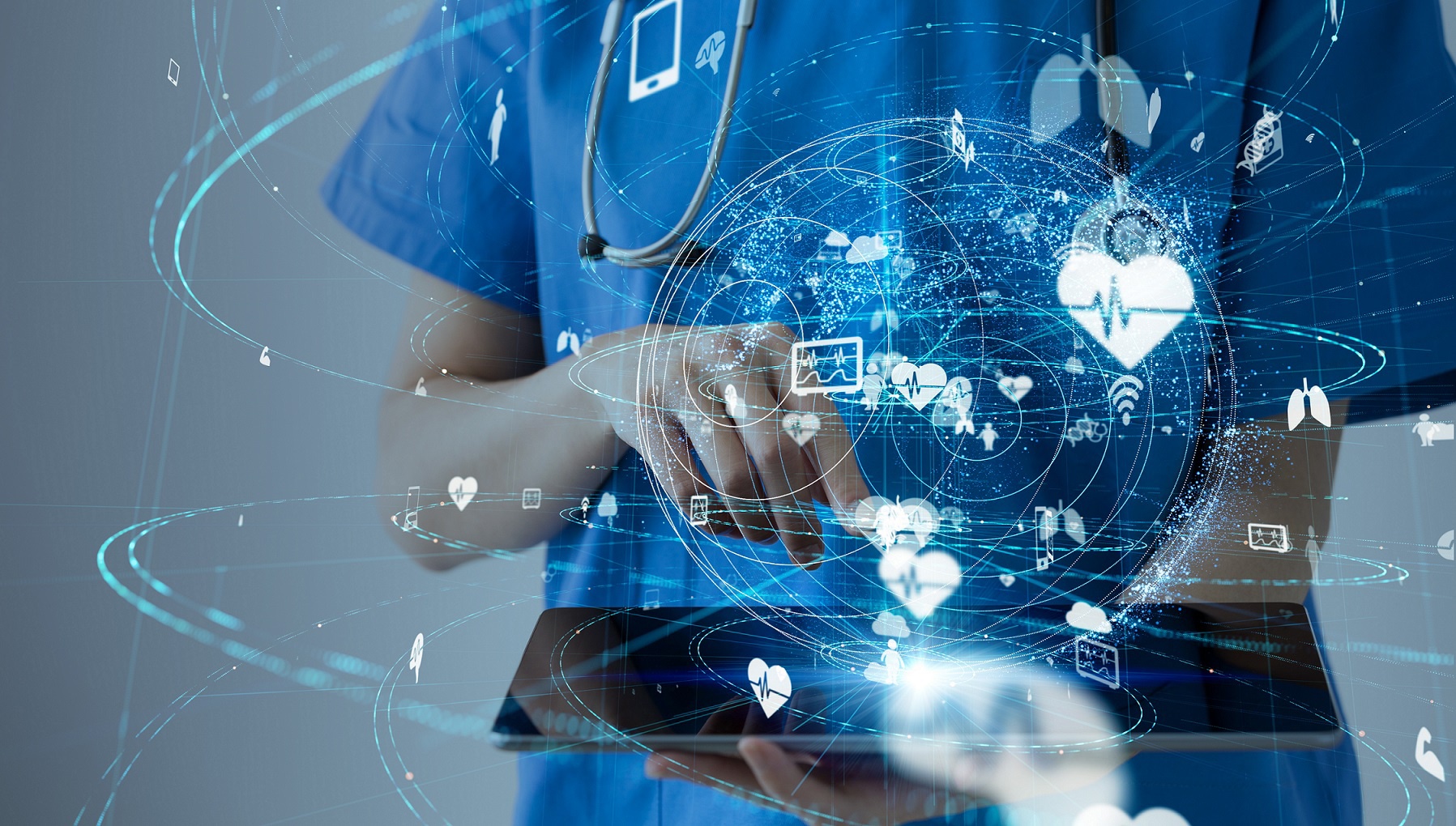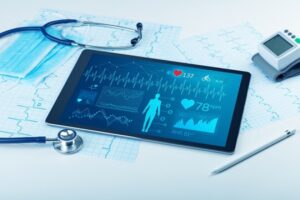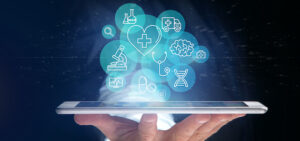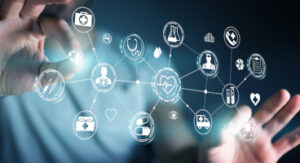Advancements in technology have made our lives easier. And one of its biggest contributions is increased accessibility across various industries.
An excellent example of this is the proliferation of telehealth apps. They bring patients closer to their healthcare providers, which leads to numerous benefits. Telehealth applications are bringing significant change to the eHealth landscape.
The global telemedicine market is projected to grow to $149.56 billion by 2028, from a value of $60.15 billion in 2023. There is no doubt that telemedicine is one of the biggest trends in healthcare right now. And if you’re developing a product for this market, you must keep up with the latest trends and knowledge on the scope of related technology.
Many different types of services are classified under telemedicine. In this article, we discuss seven telehealth applications driving change in 2023 and beyond. Keep reading to learn more about these apps and their many benefits.

Telehealth Apps Benefits
Telemedicine provides access to healthcare support and services without an in-person office visit. From video conferencing to live chatting and secure file sharing, telemedicine supports a range of healthcare services. All you need is a smartphone, tablet, or laptop that connects to the internet.
Here’s a closer look at the benefits telehealth applications bring to healthcare providers and their patients:
Treatment Availability
Accessing medical checkups, consultations, or treatments can be difficult for some patients. The reason can be the physical distance from clinics or conditions and disabilities preventing them from leaving home.
In some cases, traveling can be dangerous for patients or healthcare providers. Some patients might need a specialist consultation that isn’t locally available.
Telehealth applications help such patients to get the medical assistance they need from the comfort of their homes. Patients can connect with doctors via live chat or live video as long as they have an internet connection and a communication device.
The easy availability of consultations and treatments also makes it convenient for patients to seek help for routine complaints, which they may not otherwise bother a doctor with.
All Data in One Place
Telehealth apps provide doctors and patients easy access to relevant medical information at all times. Patients don’t need to carry their own paperwork or worry about misplacing test results—all of it is automatically logged on their digital records.
Doctors can look up a patient’s medical information easily and share their observations with other professionals to arrive at an accurate diagnosis or provide effective treatment. This system also helps healthcare providers access key data, such as blood type and allergies, during emergencies.
A key aspect where telehealth apps differ from one another is in their data protection features. Data security is critical because these apps store, transfer, and manage sensitive patient information. U.S. legislation created the Health Insurance Portability and Accountability Act (HIPAA), and legitimate companies must comply with these provisions.
Healthcare Availability 24/7
Telehealth applications ensure patients can access medical support 24/7. From specialist services to pre/post-appointment consultations and at-home treatments, patients can avail of all forms of healthcare services from just about anywhere and at any time.
Depending on your needs, these services are available via video call or live text chat.
Patient Mentorship
Facilitating mentorship for patients is much easier with technological tools. Telehealth applications can help streamline tasks like appointment booking, health tracking, and reminder setting for medications and consultations.
Some apps may also serve as a collaborative tool between multiple healthcare professionals or departments to discuss patient treatment. When combined with wearable devices, these solutions help healthcare professionals mentor their patients through treatment as they monitor their pulse, heart rate, and other important vitals.
Automated Processes
Bureaucratic processes often get in the way of effective healthcare. It prevents frontline workers from addressing patients’ needs promptly and effectively, which is central during emergencies.
With the integration of artificial intelligence (AI), telehealth applications can read and analyze data to piece together various information. This automates a majority of administrative processes, thereby helping healthcare staff deliver more value in a timely manner.
What’s more?
Automated processes also reduce manual paperwork, greatly minimizing the time spent preparing, gathering, and maintaining such documents.
Top 7 Apps for Telehealth
Whether you’re looking for inspiration to develop your own telehealth app or trying to learn about successful products on the market, here’s a list you must check out:
Telehealth by SimplePractice
Telehealth by SimplePractice is an all-in-one healthcare practice management software. It facilitates a wide range of processes for private healthcare practitioners, from scheduling appointments and documentation to billing and client communication. Its video feature supports screen share, an on-call chat window, appointment timers, and a built-in whiteboard.
Moreover, it offers private practitioners the option to build their professional websites without any web development knowledge.
Its key features include the following:
- HIPAA-compliant and HITRUST CSF-certified
- Calendar sync and reminders
- Chat during calls
- Live support
- Video conferencing
- Automated payment processes
- Custom templates for intake forms, treatment plans, etc.
- Paperless documentation and file sharing
- Customizable backgrounds
The app has a 4.6-star rating on the Google Play Store and a 4.7-star rating on the Apple Store. It is available as a free download with paid subscription plans starting at $15 per month. You can also try its features at no cost with a 30-day free trial.
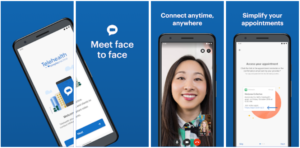
Sydney Health
Sydney Health is a popular Australia-based telehealth app that helps users manage their health. You can find virtual care, share your digital ID card and medical data, check claims, and refill prescriptions from anywhere.
The app’s key features include:
- Virtual care (chat and video)
- Live chat
- Digital ID card
- Claim submission and tracking
- Care search and cost comparison
- Incentive tracking and management
- Personalized action plans and dashboard
- Pharmacy
The Sydney Health app has a 4.6-star rating on Google Play Store and a 4.8-star rating on the Apple Store. It is a free app and only needs an email registration to start.
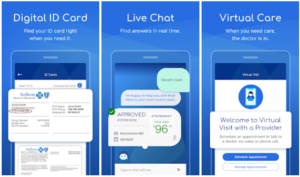
Doximity
The Doximity app is a U.S.-based telehealth app for healthcare professionals that allows reaching and managing patients, reading personalized news, and earning medical credits. Healthcare practitioners can reach patients in an instant from anywhere and anytime. Practitioners can also call or leave voicemails for patients from their cell phones while displaying their office numbers.
Some of its other key features include:
- HIPAA-compliant messaging
- Video and voice calling
- Document sharing
- On-the-go fax
- Collaborative calling
- U.S. clinician directory
- Personalized news
- Medical education credits (CME)
The Doximity app has a 4.6-star rating on Google Store and a 4.8-star rating on Apple Store. The app is free for MDs, DOs, NPs, PAs, pharm students, pharmacists, and med students.
Individual clinicians and small practices can access its Dialer Pro version for $19.99 per user per month. Enterprises can access customized features of the app for a custom price. Clinics providing free services to their community can apply for a discount.
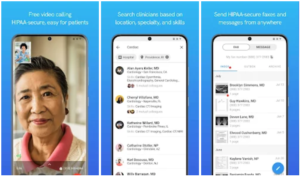
MDLIVE
MDLIVE is a telehealth app that provides patients access to primary care, routine checkups, urgent care, and more medical services at their fingertips. It covers a variety of health issues, from dermatology and mental health to urgent care and wellness screenings. You can access the services of a doctor in as little as 15 minutes or book an appointment in advance.
Here are some of the key features you can access via the MDLIVE app:
- Appointment scheduling
- Video conferencing
- ePrescriptions
- Directory of U.S.-based healthcare professionals
- Online/phone-based consultations
- Billing
MDLIVE has a 4.6-star rating from reviews on Google Store and a 4.7-star rating in the Apple Store. It’s available as an app for no cost, and users are only charged for doctor visits.
The pricing varies per provider based on the insurance plan and treatment/consultation type. It can be as low as $0 or as high as $300.
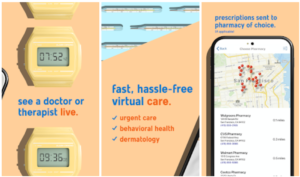
LiveHealth Online Mobile
LiveHealth Online is a 24/7 doctor search platform for medical, allergy, psychology, and psychiatry-related concerns. It offers instant and appointment-based access (within four days) to healthcare professionals of your choice.
The app also integrates with Apple Health, making it easy for patients to share their medical information with healthcare providers during their appointment.
Its key features include:
- 24/7 virtual care
- Doctor directories with ranking
- Appointment scheduling
- Secure video calling
- Pharmacy and ePrescriptions
The LiveHealth Online Mobile app has a 4.5-star rating from Google Store reviews and a 4.9-star rating in the Apple Store. The app is free to sign up for and use; you only have to pay for doctor visits.
The pricing for the visits depends on your insurance plan and the type of service you’re requesting.
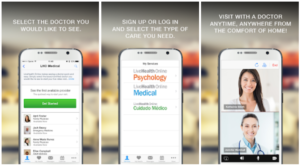
HealthTap
HealthTap is a telehealth app that brings U.S.-based healthcare support to patients anywhere in the country. It provides ongoing care, primary care, urgent care, and more right at patients’ fingertips. It focuses on making healthcare solutions accessible and affordable, with discount coupons on prescription medicines.
HealthTap also offers the following features:
- Video and chat
- Appointment scheduling and reminders
- Unlimited medical records storage
- Nurse and support staff-assisted chatbot
- Personalized treatment plans
- Fast and low-cost ePrescriptions (compare costs and coupons)
- Lab tests
- Specialist referrals
- Doctor Q&A (ask anonymously)
The HealthTap app has a 4.6-star rating on Google Store and a 4.8-star on the Apple Store.
The app is free to download and costs a base $15 fee per month to access subscription-based features. This includes your choice of doctor, video visits at $44 or less, free text messaging, anytime urgent care, and much more. Non-subscribers can access 24/7 on-demand urgent care visits at $129 per visit or their insurance copay.
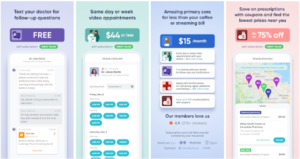
Amwell: Doctor Visits 24/7
Amwell is a web and app-based telehealth service that covers specialty care, urgent care, and behavioral health needs. It covers a wide range of health conditions and has an extensive database of practitioners. You can review each healthcare provider by their experience and rating before scheduling a consultation.
Amwell is a fantastic platform because its services are accessible to users with or without insurance.
Amwell’s best features include:
- Care finder
- HIPAA-compliant video visits
- Appointment scheduling
- Reminders
- Collaborative care (mental and physical health care coordination)
- Pharmacy services and electronic prescriptions
The Amwell app has a 4.3-star rating on Google Store and a 4.9-star rating on the Apple Store.
The app is free to download, sign-up, and use. Users are charged depending on treatment/consultation type, service type, and health plan.
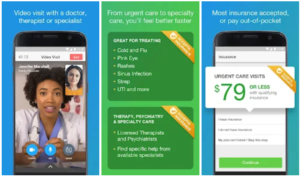
How Can RoveTek Help You Design a Telehealth App?

These are some of the best telehealth applications of 2023 that can help you understand how to build your own telehealth app service. From automated scheduling and reminders to AI-based symptom checkers, you can include plenty of features in your app to make it a success.
Understanding patient needs and design tricks in healthcare is key. At Rovetek, we’ve done the legwork in researching the best back-end and front-end solutions for your telehealth app. Whether your main concern is optimum security, improved functionality, or both, we can deliver a comprehensive solution.
If you plan to develop your telehealth app but are stuck in the development stage, Rovetek can help resolve your issues. Our team of developers and tech entrepreneurs can take over and bring your products into the global market.
Daily workouts, healthy eating, digital sports products—we have worked on a wide range of products in the telehealth industry.
Tell us your vision for the next big thing in healthcare, and watch us turn it into reality!


